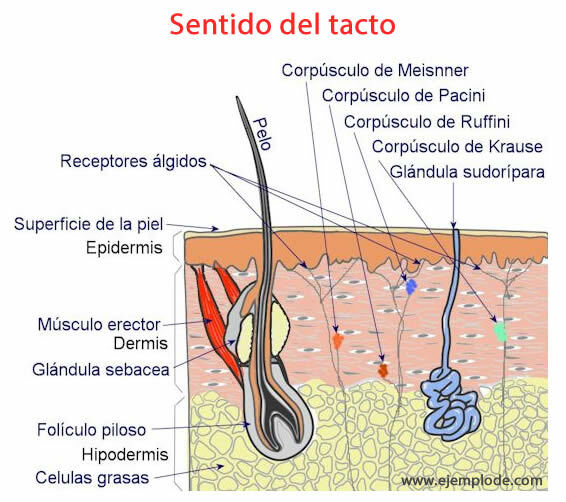Sense of Touch Example
Biology / / July 04, 2021
The sense of touchallows us to know the objects that surround us through their surface. Through touch we can feel if a surface is soft, hard, rough, wet, dry, warm, hot, etc.
The touch receptors are distributed throughout our skin. However, not all parts of our skin have the same number of receptors or the same sensitivity. The most sensitive areas of our skin are found on the face and hands, and the area of our least sensitive skin is found on our back.
Part of the sense of touch are also painful sensations, which occur when a stimulus is too intense.

Layers of skin:
The epidermis It is the most superficial layer of the skin. In the most superficial part a layer of keratinized dead cells forms, which are shed as dust or tiny flakes. It is the outer part of our skin and serves as protection against the elements. Lower down the same cells are constantly being renewed and pushing dead cells out.
The dermis It is the middle layer of the skin. Some important skin structures are found in the dermis, such as hair follicles, sweat glands, blood vessels, and erector hair muscles. Most receptors for the sense of touch are also found in this layer.
The hypodermis It is the deepest layer of the skin, which has contact with the subcutaneous fat and the muscles and other structures inside the body.
Receptors for the sense of touch:
Receptors for the sense of touch are connected to the nervous system and are found in different layers of the skin.
High receptors. Also called pain receptors, they are free nerve endings found in the deepest part of the epidermis, where it meets the dermis. These receptors run parallel to the other receptors, and collectively capture the stimuli, activating pain perceptions when any of the stimuli in the corpuscles is too much strong.
Meisnner corpuscles. They are the receptors in charge of perceiving touch as such, that is, of feeling the shape, size and whether an object is smooth or rough. They are found in the dermis.
Pacini corpuscles. These corpuscles, which are also found in the dermis, allow us to obtain the sensations of pressure, as well as the hardness of an object.
Ruffini corpuscles. Heat and temperatures above body temperature (more than 36 or 37 degrees Celsius) are perceived through these receptors.
Krause corpuscles. These receptors perceive low temperatures, below body temperature, they are cold receptors.
